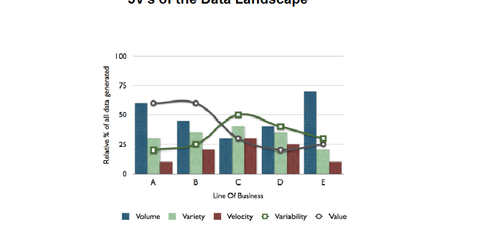Overview: What is “big data”?
Big data is high volume, high velocity, and high variety information assets that require new forms of processing to enable enhanced decision making, insight, discovery, and process optimization.
Aug. 1 2014, Updated 1:02 a.m. ET

“Big data”
“Big data” analytics is creating buzz everywhere. Organizations and C level executives all across the world can’t stop talking about its disruptive power in transforming businesses. IBM (IBM) states that they create 2.5 quintillion bytes of data every day and ~90% of the data in the world today has been created in the last two years. Splunk (SPLK) and Tableau Software (DATA), Attunity, Qlik Technologies (QLIK), and Teradata (TDC) are everywhere. They have to be because they’re leading “big data” companies. Splunk, a machine data analytics software vendor, generates 100% of its revenue from “big data.” Tableau is an analytics, data visualization software firm that presents complex data in an easy-to-grasp manner.
What is big data?
According to Gartner, “Big data is high volume, high velocity, and high variety information assets that require new forms of processing to enable enhanced decision making, insight, discovery, and process optimization.” Wikibon reported that the “big data” market revenue stood at $18.6 billion in 2013, compared to $11.8 billion in 2012, registering a growth of 58%. It has the potential to cross $50 billion by 2017. It’s expected to grow every year compounded annually, 2011–2017, at 38%.
Five v’s of “big data”
The previous chart shows five v’s associated with “big data.” According to NIST, volume, variety and velocity are the three v’s that define “big data.” However, industry experts have gone a step further to include two more v’s to define “big data.”
• Volume refers to the large quantity of data
• Variety refers to diverse types and formats of data generation sourced from various mechanisms—for example, social networking videos, and feeds
• Velocity refers to the speed of data inflow and the rate at which this data needs to be processed
• Variability refers to the data sourced from varied places that requires testing of its quality
• Value refers to use all the data sourced to be put in productive and value oriented results
Businesses have thrived on their ability to derive insights from information or data, which has grown exponentially with the advent of social media and mobile technology. It has helped them make better, smarter, real time, and fact-based decisions. This demand for intensity of knowledge is what many believe has fueled the growth of “big data.”
